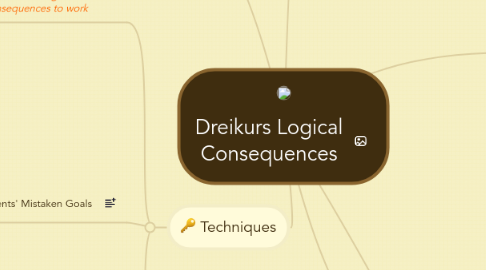
1. Motives for Behaviour
1.1. Gaining Attention
1.1.1. Active-Constructive
1.1.2. Passive-Constructive
1.1.3. Active-Destructive
1.1.4. Passive-Destructive
1.2. Exercising Power
1.3. Exacting Revenge
1.4. Displaying Inadequacy
2. Techniques
2.1. Assumption: teachers must already have established a good relationship with students for Logical Consequences to work
2.2. Understanding Students' Mistaken Goals
2.2.1. Dreikurs et al (1982) postulates that teachers should ask a few key questions to reveal their goals
2.2.2. Do you know why you _____? (even if s/he does not know, ask to lead in to next question)
2.2.3. I would like to tell you what I think.
2.2.3.1. Gaining Attention: Could it be that you want me to notice you more? Could it be that you want me to do something special for you? Could it be that you want to be special to the group?
2.2.3.2. Exercising Power: Could it be that you want to be the boss? Could it be that you insist on doing what you want to do?
2.2.3.3. Exacting Revenge: Could it be that you want to get even with me? Could it be that you want to show me how much you hated what I did?
2.2.3.4. Displaying Inadequacy: Could it be that you want to be left alone because you believe that you can do anything? Could it be that you want to be left alone because you can't be on top?
2.3. Helping Students Change their Mistaken Goals
2.3.1. Dealing with Attention-seeking behaviour
2.3.2. Dealing with Power-seeking behaviour
2.3.3. Dealing with Revenge-seeking behaviour
2.3.4. Dealing with Displays of Inadequacy
3. Preventing Discipline Problems
3.1. Encouragement versus Praise
3.2. Logical Consequences
3.3. Discussions in the Classroom
3.4. Preventive Discipline Suggestions
4. Teaching Styles
4.1. Autocratic
4.2. Permissive
4.3. Democratic
5. Helping students correct their Behaviour (Dinkmeyer et al,1976)
5.1. Teachers attempt to ascertain students' motives
5.2. Students are helped to understand their motives
5.3. Students are helped to exchange their mistaken goals for useful ones
5.4. Students are encouraged to become committed to their new goal orientation
5.5. Students are taught to apply logical consequences
5.6. Group discussions regarding class rules and problems are held
6. Strengths and Weaknesses
6.1. Strengths
6.1.1. Promotes a degree of autonomy
6.1.2. Incorporates preventive approach to discipline
6.1.3. Helps students understand why they behave as they do
6.1.4. Helps students learn correct behaviour
6.1.5. Promotes mutual respect
6.1.6. Relies on logical consequences than arbitrary punishment
6.1.7. Helps teachers focus on causes before taking action
6.2. Weaknesses
6.2.1. Teachers might misidentify actual motives of students
6.2.2. Students may not admit their real motives
6.2.3. Some teachers may find it difficult to be non-controlling
6.2.4. Some teachers may find it unnatural or engage in dialogue with students (like me)
